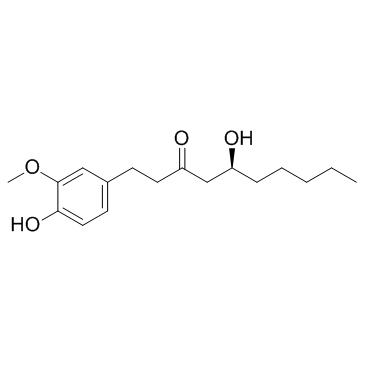23513-14-6
| Name | gingerol |
|---|---|
| Synonyms |
3-Decanone, 5-hydroxy-1-(4-hydroxy-3-methoxyphenyl)-, (S)-(+)-
(S)-5-Hydroxy-1-(4-hydroxy-3-methoxyphenyl)decan-3-one 3-Decanone (5-hydroxy-1-(4-hydroxy-3-methoxyphenyl) (+)-Gingerol (S)-[6]Gingerol (S)-5-Hydroxy-1-(4-hydroxy-3-methoxyphenyl)-3-decanone 3-Decanone, 5-hydroxy-1-(4-hydroxy-3-methoxyphenyl)-, (S)- 3-Decanone, 5-hydroxy-1-(4-hydroxy-3-methoxyphenyl)-, (5S)- (+)-5-Hydroxy-1-(4-hydroxy-3-methoxyphenyl)-3-decanone (S)-(+)-[6]Gingerol (+)-[6]-Gingerol 6-Gingerol (S)-(6)-Gingerol (5S)-5-Hydroxy-1-(4-hydroxy-3-methoxy-phenyl)decan-3-one Gingerol UNII-925QK2Z900 (5S)-5-Hydroxy-1-(4-hydroxy-3-methoxyphenyl)-3-decanone (5S)-5-Hydroxy-1-(4-hydroxy-3-methoxyphenyl)decan-3-one MFCD00210507 [6]-Gingerol |
| Description | [6]-Gingerol is an active compound isolated from Ginger (Zingiber officinale Rosc), exhibits a variety of biological activities including anticancer, anti-inflammation, and anti-oxidation. |
|---|---|
| Related Catalog | |
| Target |
AMPK Apoptosis |
| In Vitro | [6]-gingerol inhibits colon cancer cell proliferation and induced apoptosis, while the normal colon cells are unaffected. [6]-gingerol down-regulates phorbol myristate acetate induced phosphorylation of ERK1/2 and JNK MAP kinases and activation of AP-1 transcription factor, but has only little effects on phosphorylation of p38 MAP kinase and activation of NF-kappa B[1]. [6]-gingerol treatment is shown to restore impaired intestinal barrier function and to suppress proinflammatory responses in DSS-treated Caco-2 monolayers. AMPK is activated on [6]-gingerol treatment[2]. Treatment with [6]-gingerol results in a significant decrease in the viability of osteosarcoma cells in a dose-dependent fashion. In parallel, the number of cells arrested at the sub-G1 cell cycle phase is significantly increased. [6]-gingerol induces activation of caspase cascades and regulates cellular levels of Bcl2 and Bax[3]. |
| In Vivo | In animal studies, [6]-gingerol significantly ameliorates DSS-induced colitis by restoration of body weight loss, reduction in intestinal bleeding, and prevention of colon length shortening. In addition, [6]-gingerol suppresses DSS-elevated production of proinflammatory cytokines (IL-1β, TNFα, and IL-12)[2]. |
| Cell Assay | [6]-gingerol stock (20 mg/mL) is prepared in ethanol and the working concentrations are prepared by diluting this stock in dimethyl sufoxide (DMSO). For MTT assay, 5×103 cells/well of human colon cancer cells and 104 cells/well of mouse IECs are seeded in 96-well plates. Cells are treated with [6]-gingerol for 48 h,72 h or 96 h before performing MTT assay and for 16 h before Annexin-V staining[1]. |
| Animal Admin | Mice: Mice with DSS-induced colitis are given different oral dosages of [6]-gingerol daily for 14 days. Body weight and colon inflammation are evaluated, and level of proinflammatory cytokines in colon tissues is measured[2]. |
| References |
| Density | 1.1±0.1 g/cm3 |
|---|---|
| Boiling Point | 453.0±35.0 °C at 760 mmHg |
| Melting Point | 30 - 32ºC |
| Molecular Formula | C17H26O4 |
| Molecular Weight | 294.386 |
| Flash Point | 159.0±19.4 °C |
| Exact Mass | 294.183105 |
| PSA | 66.76000 |
| LogP | 2.48 |
| Vapour Pressure | 0.0±1.2 mmHg at 25°C |
| Index of Refraction | 1.523 |
| Storage condition | ?20°C |
CHEMICAL IDENTIFICATION
HEALTH HAZARD DATAACUTE TOXICITY DATA
MUTATION DATA
|
| Symbol |

GHS06 |
|---|---|
| Signal Word | Danger |
| Hazard Statements | H301-H315-H319-H335 |
| Precautionary Statements | P261-P301 + P310-P305 + P351 + P338 |
| Personal Protective Equipment | dust mask type N95 (US);Eyeshields;Faceshields;Gloves |
| Hazard Codes | Xi |
| Risk Phrases | R36/37/38:Irritating to eyes, respiratory system and skin . |
| Safety Phrases | S26-S36 |
| RIDADR | UN 2811 6.1 / PGIII |
| RTECS | HE0757000 |
| HS Code | 2914509090 |
| HS Code | 2914509090 |
|---|---|
| Summary | HS:2914509090 other ketones with other oxygen function VAT:17.0% Tax rebate rate:9.0% Supervision conditions:none MFN tariff:5.5% General tariff:30.0% |


